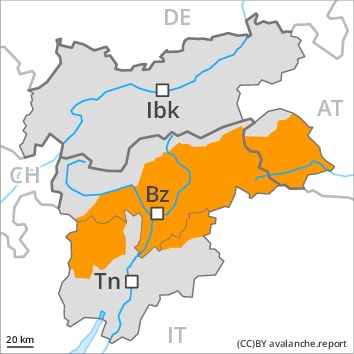
Danger level
 | treeline
|
Avalanche Problem
 | | Wind-drifted snow |
|  | |  |
 | | Gliding snow |
|  | |  |

The weather report and anticipated change in the avalanche danger are uncertain.
As a consequence of highly fluctuating temperatures rain up to intermediate altitudes and the strong to storm force westerly wind, a very precarious avalanche situation developed. Fresh and older wind slabs are poorly bonded with the old snowpack in all aspects above the tree line. As a consequence of new snow and strong wind natural avalanches are possible at any time, even quite large ones. The fresh wind slabs can be released even by a single winter sport participant. Additionally avalanches can also penetrate deep layers and reach large size in isolated cases.
As the snowfall level rises more frequent medium-sized and, in isolated cases, large moist snow slides and avalanches are possible below approximately 2400 m. Gliding avalanches can also occur. Precautionary safety measures may be necessary in some localities.
Snowpack
dp.6: cold, loose snow and wind
Significant warming: In particular along the border with Tirol and Begin: South Tyrol 5 to 30 cm of snow will fall until Saturday above approximately 2000 m. The snowpack will become moist below approximately 2200 m. The wind will be strong to storm force. Over a wide area new snow and wind slabs are lying on soft layers.
Distinct weak layers exist in the centre of the snowpack. These can be released. Caution is to be exercised at their margins in particular. Towards its base, the snowpack is largely stable.
Tendency
Hardly any decrease in avalanche danger.

Danger level
 | treeline
|
Avalanche Problem
 | | Wind-drifted snow |
|  | |  |
 | | Persistent weak layer |
|  | |  |

The avalanche conditions remain dangerous.
The fresh and somewhat older wind slabs are lying on unfavourable layers in all aspects. They can in many places be released, even by a single winter sport participant or triggered naturally. Caution is to be exercised in case of releases originating from, high-altitude starting zones that have retained the snow thus far, especially in the regions neighbouring those that are subject to danger level 4 (high). Avalanches can also be released in the old snowpack and reach quite a large size. Remotely triggered avalanches are possible.
In the regions with a lot of snow gliding avalanches are possible, even quite large ones. Gradual increase in danger of wet and gliding avalanches as the moisture increases. In the regions where rain falls the avalanche danger is greater. Selective safety measures may be necessary in some localities.
The conditions are precarious for snow sport activities. Caution and restraint are recommended.
Snowpack
dp.6: cold, loose snow and wind
dp.2: gliding snow
The strong wind will transport the fresh and old snow. The various wind slabs have bonded insufficiently together. In some places new snow and wind slabs are lying on soft layers.
In its middle, the snowpack is weak. Towards its base, the snowpack is largely stable. Whumpfing sounds and the formation of shooting cracks when stepping on the snowpack serve as an alarm indicating the danger.
Tendency
A precarious avalanche situation will persist in some cases. Temporary increase in danger of dry and moist avalanches as a consequence of warming, in particular below approximately 2400 m.












